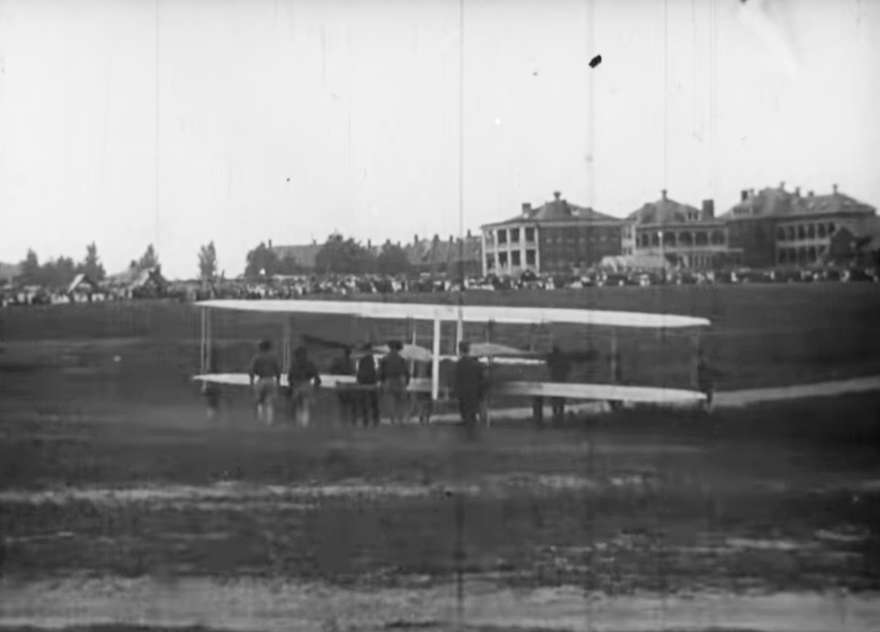First Army Aeroplane Flight
7/27/1909
Add to Favorites:
Add all page(s) of this document to activity:

This silent film shows the first Army airplane flight, that of the Wright Brothers' "Wright Flyer" during trials at Fort Myer, VA, in 1909.
After the Wright Brothers made their famous first flight on December 17, 1903, the U.S. military took an interest in their flying machine. On December 23, 1907, the US Army issued Specification No. 486, outlining parameters for a heavier-than-air flying machine. The competition was open to all bidders, but the Wright Brothers' airplane was the only real contender.
The field trials of the plane were set for late summer 1908 at Ft. Myers, Virginia. After an unsuccessful and tragic first attempt on September 17, 1908, in which Army observer Lieutenant Thomas E. Selfridge was killed, the trials were put on hold. They were resumed in June 1909.
That first successful flight was captured on film on July 27, 1909. Orville Wright was flying the plane, with Army Lieutenant Frank P. Lahm observing. Wright and Lahm set the world's endurance record of one hour 12 minutes and 40 seconds. This film shows high ranking officers and officials, including President Taft and First Lady Helen Taft, looking on.
The original shot list reads: MS of small group standing at door of hangar. Crowds around hangar. Opening doors of hangar. Dignitaries greeting each other. MS of soldiers removing doors from hangar. Pushing plane sideways out of hangar. Soldiers turning plane around. LS of pulling plane out to field. MS preparation of aircraft for take off. Lt. Lahm sitting at controls, Wright standing in front and releasing ropes. Lt. Lahm and Orville Wright take seats in plane. LS of men standing beside catapult and in front of buildings. Men pulling up weight of catapult. LS of catapult from front of plane. MS of catapult from behind plane. LS of taking off. MS of plane taking off. Plane in flight. Plane circles around field, over buildings. LS headquarters building in background. LS of flying field. Plane in flight. Plane landing. LS of plane on field after flight. Moving plane off field. Army personnel grouped around the Wright aircraft. CU of plane. Wright getting out of plane.
After the Wright Brothers made their famous first flight on December 17, 1903, the U.S. military took an interest in their flying machine. On December 23, 1907, the US Army issued Specification No. 486, outlining parameters for a heavier-than-air flying machine. The competition was open to all bidders, but the Wright Brothers' airplane was the only real contender.
The field trials of the plane were set for late summer 1908 at Ft. Myers, Virginia. After an unsuccessful and tragic first attempt on September 17, 1908, in which Army observer Lieutenant Thomas E. Selfridge was killed, the trials were put on hold. They were resumed in June 1909.
That first successful flight was captured on film on July 27, 1909. Orville Wright was flying the plane, with Army Lieutenant Frank P. Lahm observing. Wright and Lahm set the world's endurance record of one hour 12 minutes and 40 seconds. This film shows high ranking officers and officials, including President Taft and First Lady Helen Taft, looking on.
The original shot list reads: MS of small group standing at door of hangar. Crowds around hangar. Opening doors of hangar. Dignitaries greeting each other. MS of soldiers removing doors from hangar. Pushing plane sideways out of hangar. Soldiers turning plane around. LS of pulling plane out to field. MS preparation of aircraft for take off. Lt. Lahm sitting at controls, Wright standing in front and releasing ropes. Lt. Lahm and Orville Wright take seats in plane. LS of men standing beside catapult and in front of buildings. Men pulling up weight of catapult. LS of catapult from front of plane. MS of catapult from behind plane. LS of taking off. MS of plane taking off. Plane in flight. Plane circles around field, over buildings. LS headquarters building in background. LS of flying field. Plane in flight. Plane landing. LS of plane on field after flight. Moving plane off field. Army personnel grouped around the Wright aircraft. CU of plane. Wright getting out of plane.
This primary source comes from the Records of the Office of the Chief Signal Officer.
National Archives Identifier: 24690
Full Citation: Motion Picture 111-H-1185; First Army Aeroplane Flight, Fort Myer, Virginia; 7/27/1909; Historical Films, ca. 1914 - ca. 1936; Records of the Office of the Chief Signal Officer, Record Group 111; National Archives at College Park, College Park, MD. [Online Version, https://www.docsteach.org/documents/document/wright-flyer-first-army-flight, April 23, 2024]Rights: Public Domain, Free of Known Copyright Restrictions. Learn more on our privacy and legal page.



